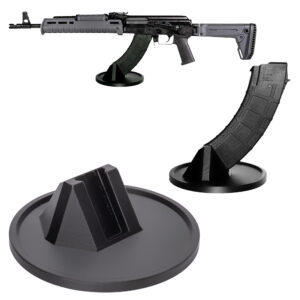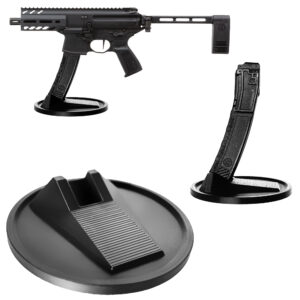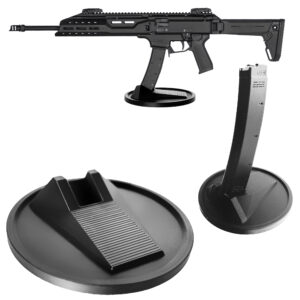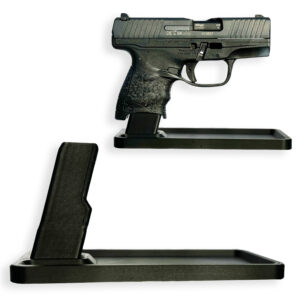Categories:
When it comes to owning and operating an AR-15 rifle, choosing the right ammunition is crucial. The AR-15 platform has gained immense popularity due to its versatility, reliability, and ease of customization. However, without proper knowledge about ammunition types and their performance characteristics, one might not fully harness the potential of this iconic gun. Selecting suitable ammunition for your AR-15 requires consideration of various factors such as intended purpose, range limitations, and individual preferences.
Different types of ammunition offer unique advantages and performance attributes that can greatly affect accuracy, terminal ballistics, recoil management, and overall shooting experience. One primary factor to consider is bullet weight. Ammunition manufacturers offer a range of bullet weights for the .223/5.56mm caliber typically used in an AR-15. Lighter bullets generally travel faster but may sacrifice terminal performance at longer distances.
On the other hand, heavier bullets tend to retain energy better over long ranges but may have more significant recoil. Another important consideration is bullet construction. Ammunition with hollow point or soft point bullets is commonly used for hunting applications due to their controlled expansion upon impact with a target. Full metal jacket (FMJ) rounds are typically used for training purposes or in situations where over-penetration is a concern.
Understanding how different ammo types perform in specific scenarios will help you make informed decisions based on your shooting requirements. By selecting appropriate ammunition for your AR-15 rifle, you can optimize accuracy while ensuring reliable cycling and minimizing wear on your gun.
When it comes to choosing the right ammunition for your AR-15, understanding the different types available is crucial. Each type of ammunition offers varying performance characteristics, making it essential to select the one that best suits your intended use. Here are some basics to help you explore the various types of AR-15 ammunition and their performance. 1. Full Metal Jacket (FMJ): This is a popular choice for target shooting and training purposes.
FMJ rounds feature a soft lead core encased in a harder metal shell, ensuring reliable feeding and reduced fouling in the barrel. 2. Hollow Point (HP): Designed for self-defense applications, HP rounds have a hollow cavity at the tip that allows for controlled expansion upon impact. This expansion creates larger wound channels and transfers more energy to the target, making it an effective choice for personal protection.
3. Ballistic Tip: These bullets feature a plastic tip over a lead core, enhancing long-range accuracy by improving aerodynamics and reducing drag. Ballistic Tip ammunition is commonly used by hunters as it provides rapid expansion upon impact, causing significant tissue damage. 4. Match Grade: Specially manufactured for precision shooting competitions or long-range engagements, match-grade ammunition offers exceptional consistency in terms of velocity and trajectory.
These rounds are carefully crafted to deliver outstanding accuracy under demanding conditions. 5. Frangible: Frangible ammo is designed to break apart upon impact with hard surfaces like steel plates or walls, minimizing the risk of ricochets or over-penetration during close-quarters training or self-defense scenarios.
When it comes to selecting the best ammunition for your AR-15, considering the caliber is crucial. The caliber refers to the diameter of the bullet and plays a significant role in determining the overall performance and suitability of ammunition for your specific needs. One of the most common calibers for AR-15 rifles is .223 Remington/5.56 NATO. This caliber is known for its versatility, offering a wide range of ammunition options suitable for various applications such as target shooting, hunting, and self-defense.
It provides excellent accuracy, manageable recoil, and effective terminal ballistics. If you are looking for more power or longer-range capabilities, you might consider calibers like .300 AAC Blackout or 6.5 Grendel. These calibers offer enhanced stopping power while maintaining compatibility with standard AR-15 magazines and lower receivers. For long-range precision shooting or competitions, calibers like .308 Winchester/7.62 NATO can be excellent choices due to their superior ballistic performance and extended effective range.
Additionally, it’s essential to consider your local regulations and restrictions when choosing a caliber. Some states have specific rules regarding certain calibers or may limit their use in certain areas due to concerns about safety or environmental impact. Ultimately, selecting the right caliber depends on your intended purpose for using an AR-15 rifle.
When it comes to choosing the right ammunition for your AR-15, understanding the various bullet types and their construction is crucial. The performance of a bullet can vary significantly depending on its design, materials used, and intended purpose. Here are some factors to consider when evaluating bullet performance. One key aspect to examine is the bullet’s shape. Different shapes have distinct advantages and disadvantages.
For instance, a round-nose bullet provides better penetration and energy transfer upon impact, making it suitable for hunting purposes. On the other hand, a hollow-point bullet expands upon impact, creating a larger wound channel and transferring more energy to the target. This type of bullet is often favored for self-defense applications. Another critical factor is the construction of the bullet itself.
Most modern bullets are constructed using either full metal jacket (FMJ) or open-tip match (OTM) designs. FMJ bullets have a soft lead core encased in a harder metal shell, which helps prevent deformation during feeding and firing but may sacrifice terminal performance. OTM bullets offer improved accuracy due to their consistent weight distribution but still maintain excellent terminal performance thanks to an exposed lead tip that allows controlled expansion upon impact.
It’s also worth considering specialized bullets such as armor-piercing (AP) or frangible rounds that are designed for specific applications like piercing body armor or minimizing collateral damage in close-quarters combat scenarios. In conclusion, evaluating performance factors when selecting AR-15 ammunition involves assessing aspects like shape, construction type (FMJ or OTM), as well as considering specialized bullets tailored for unique scenarios.
When it comes to choosing the right AR-15 ammunition, considering the velocity and energy characteristics is crucial for optimizing performance. The velocity of a bullet refers to its speed as it travels down the barrel, while energy relates to the force it carries upon impact. Understanding these factors is essential for achieving accuracy, reliability, and desired terminal effects. Higher velocities generally result in flatter trajectories, meaning that the bullet will have less drop over longer distances.
This can be advantageous for precision shooting or hunting scenarios where long-range shots are common. Additionally, higher velocities can enhance penetration capabilities by allowing the bullet to maintain its momentum and integrity upon impact with various barriers such as clothing or light cover. The energy carried by a bullet is directly related to its mass and velocity. More massive bullets fired at high velocities tend to deliver higher energy levels upon impact.
This increased energy transfer can lead to greater tissue damage or incapacitation potential when engaging targets. However, it’s important to strike a balance between velocity and bullet weight depending on your intended use – too much velocity without sufficient mass may result in over-penetration or reduced terminal effectiveness. Different types of ammunition are designed with specific purposes in mind, which affects their velocity and energy characteristics.
For instance, varmint rounds prioritize high velocities for accurate shots on small game animals at extended ranges. On the other hand, self-defense loads often focus on delivering controlled expansion and maximum energy transfer within shorter distances.
Accuracy and precision are crucial factors when it comes to optimizing shooting results with an AR-15. To achieve the best performance, it is essential to carefully select the right ammunition that matches the specific requirements of your shooting style and purpose.
When discussing accuracy, we refer to the ability of a bullet to consistently hit the intended target. This is influenced by various factors, including bullet design, weight, and velocity. Different types of ammunition are designed for specific purposes such as long-range shooting, close-quarters combat, or hunting. Each type has its own characteristics that affect accuracy differently.
Precision refers to how closely grouped shots are on a target. It is affected by factors like bullet consistency and quality control during manufacturing. Ammunition with consistent dimensions, weight distribution, and uniformity will provide better precision results.
To match ammo accurately and precisely with your shooting needs, consider variables such as bullet weight, shape (full metal jacket vs hollow point), ballistic coefficient (BC), muzzle velocity, and twist rate of your rifle’s barrel. For long-range shooting or precision competitions, heavier bullets with high BCs generally perform better due to their ability to maintain stability in flight.
It is crucial to conduct extensive testing using different types of ammunition under various conditions to determine which one provides the optimal balance between accuracy and precision for your particular gun setup. Remember that each rifle may have its own preferences regarding ammunition brands or loads.
By understanding these concepts and investing time in research and experimentation with different ammo types, you can maximize your AR-15’s potential for accuracy and precision while achieving excellent shooting results tailored specifically to your needs.
When it comes to choosing the right AR-15 ammo, understanding the terminal ballistics is crucial for assessing its stopping power and penetration abilities. Terminal ballistics refers to the study of a projectile’s behavior upon impact, including its ability to incapacitate a target and its ability to penetrate various barriers. Stopping power refers to the ammunition’s ability to quickly incapacitate a threat by disrupting vital organs or causing severe tissue damage.
This is typically measured by factors such as bullet design, velocity, and energy transfer. Hollow point ammunition, for example, is specifically designed to expand upon impact, maximizing tissue damage and increasing stopping power. Penetration ability is equally important as it determines whether the bullet can effectively penetrate barriers such as clothing, glass, or body armor. The ability of an AR-15 round to penetrate deeply into a target can be influenced by factors like bullet weight, shape, and composition.
Different types of ammunition have varying terminal ballistics characteristics. For instance, full metal jacket (FMJ) rounds are known for their limited expansion upon impact but offer better penetration abilities compared to hollow points. This makes FMJ rounds suitable for scenarios where over-penetration should be minimized. On the other hand, bonded bullets are designed with a lead core bonded to their jacket material which prevents separation during penetration.
These bullets tend to retain more weight after impact while expanding reliably within soft targets.
Selecting the right ammunition for your AR-15 rifle is crucial to ensure optimal performance and achieve your desired shooting results. With the myriad of options available, it can be overwhelming to make an informed decision. However, by considering certain factors and understanding the different types of ammo, you can choose wisely and maximize your shooting experience. Firstly, understanding your shooting requirements is vital in determining the appropriate ammunition type.
Are you using the AR-15 for self-defense purposes or competitive shooting? Each scenario may demand different characteristics in terms of bullet weight, velocity, and terminal performance. By identifying your specific needs, you can narrow down the choices that align with those requirements. Additionally, considering the intended range of engagement is essential when selecting ammo. Different types of ammunition excel at varying distances; therefore, being aware of how far you will typically be shooting can greatly impact your decision-making process.
For longer ranges, lighter bullets with higher velocities may be preferred, while heavier bullets might provide better accuracy at closer ranges. Furthermore, familiarizing yourself with different bullet designs and their terminal ballistics is crucial. Factors such as bullet construction (hollow points or full metal jackets), expansion capabilities upon impact, penetration depth, and energy transfer all contribute to an ammo’s performance on target.
Understanding these characteristics will allow you to select ammunition that aligns with your desired effect on game or targets. Lastly, always consider cost and availability when making a decision about which AR-15 ammo to purchase.








Colt
Colt M4 Carbine
Colt LE6920
Colt AR-15 A4
Daniel Defense
DDM4 V7
DDM4 V9
DDM4 V11
DDM4 ISR (Integrally Suppressed Rifle)
Smith & Wesson (S&W)
M&P15 Sport II
M&P15 Tactical
M&P15T
Bravo Company Manufacturing (BCM)
BCM Recce-16
BCM Recce-14
BCM MCMR Series
Aero Precision
M4E1 Series
AC-15
AR15 Pistol (Various Configurations)
Ruger
Ruger AR-556
Ruger SR-556
Ruger AR-556 MPR (Multi-Purpose Rifle)
Springfield Armory
Saint Victor
Saint Edge
Saint AR-15
PSA (Palmetto State Armory)
PSA PA-15
PSA AR-V
PSA Jakl (AR Pistol)
FN America
FN 15 Tactical Carbine
FN 15 Patrol
FN 15 DMR
Wilson Combat
Recon Tactical
Super Sniper
Protector Carbine
SIG Sauer
SIG M400 Tread
SIG M400 Elite
SIG M400 SDI
LWRC International
IC DI (Direct Impingement)
IC SPR
IC A5
Bushmaster Guns
XM-15 QRC
Bushmaster MOE
XM-15 Patrolman
Rock River Arms
LAR-15 Entry Tactical
LAR-15 Predator
LAR-15 Elite Comp
Stag Arms
Stag 15 Tactical
Stag 15L (Left-Handed Models)
Stag 15 Valkyrie
Noveske Rifleworks
Noveske Gen 4 N4
Noveske Space Invader (AR Pistol)
Noveske Recon
Anderson Manufacturing
AM-15 Optic Ready
AM-15 M4 Carbine
AM-15 Precision Rifle
Adams Arms
AA-15 Piston Rifle
P2 AARS (Adams Arms Rifle Series)
Black Rain Ordnance
SPEC15 Series
BRO Predator
Fallout 15
Diamondback Guns
DB15 Series
DB15CCMLB
DB15EB
Del-Ton Inc.
DTI-15
Del-Ton Echo 316H
Sierra 316M
Windham Weaponry
Windham SRC
Windham VEX-SS
Windham RMCS-4 (Caliber Conversion System)
Christensen Arms
CA-15 G2
CA-15 Recon
CA-15 Titanium Edition
Patriot Ordnance Factory (POF-USA)
Renegade Plus
P415 Edge
Revolution DI
LaRue Tactical
PredatAR
OBR (Optimized Battle Rifle)
LaRue Stealth 2.0
Battle Arms Development
Workhorse Patrol Carbine
BAD556-LW (Lightweight)
Authority Elite Rifle
Faxon Guns
Ascent AR-15
FX-19 (AR Pistol)
Streamline Ultralight Series
KE Arms
KE-15 SLT (Super Lightweight Tactical)
KE-15 Scout Carbine
Primary Weapons Systems (PWS)
MK1 MOD 2-M
MK116 PRO
MK107 (Piston AR Pistol)
ZEV Technologies
ZEV Core Elite Rifle
ZEV AR15 Billet Rifles
Franklin Armory
BFSIII AR-C1
Militia Model
F17-L (Chambered in .17 WSM)
Seekins Precision
SP15 DMR
NX15 Skeletonized Rifle
Havak Bravo
Aero Precision (Additional Models)
EPC-9 (Pistol Caliber ARs)
VG6 AR Rifles
Barrett Guns
REC7 DI
REC7 Gen II
CMMG
MK4 RCE
Resolute 300
Banshee (AR Pistol)
DPMS Panther Arms
Panther Oracle
Panther LR-308
H&K (Heckler & Koch)
HK MR556A1
HK416 (Military Variant)
Rock Island Armory (Armscor)
VR-80 Tactical AR (Shotgun AR Platform)
Troy Industries
Troy SPC-A3
Troy PAR (Pump Action AR)
Wilson Tactical
Tactical Recon AR
Protector Series
F1 Guns
FDR-15 Skeletonized Rifle
BDRx-15 Series
Juggernaut Tactical
JT-15
JT-10 Precision Rifle
AeroSurplus
Surplus AR-15 Rifles (Budget Models)
Thunder Tactical
AR-15 Basic Carbine
Tactical Builder Sets
Radical Guns
RF-15
Forged AR-Series
Dark Storm Industries
DS-15 Featureless Rifles
DS-10 Typhoon
DRD Tactical
Paratus
Aptus AR Rifles
Bear Creek Arsenal
BCA-15
AR Complete Upper Builds
Aero Survival Rifles (ASI)
ASR Tactical Series
Tactical Edge
WARFIGHTER Series
AR-15 Lightweight Rifles
Lone Star Armory
TX15 DMR
TX15 Carbine
HERA Arms
HERA H7
HERA AR-15 Lower Builds
IWI (Israeli Weapon Industries)
Zion-15
DRD Tactical
Tactical Modular Rifles
Quick-Takedown Rifles
V Seven Weapons
1776 Rifle
Hyperlite Rifle
Core Rifle Systems
Core15 Tac III
Core15 Patrol Rifle
Armalite (Original AR-15 Creator)
M15 Tactical
M15 A4 Carbine
DEF15 (Defensive Sporting Rifle Series)
PSA (Palmetto State Armory Additional Models)
PSAK-47 Hybrid (AR-AK Style Hybrid)
PSA Dagger (Pistol Caliber Configurations)
Odin Works
OTR-15
Odin Recon Rifle
Maxim Defense
MDX-508 PDX (Compact AR Pistol)
MDX-510 Rifle